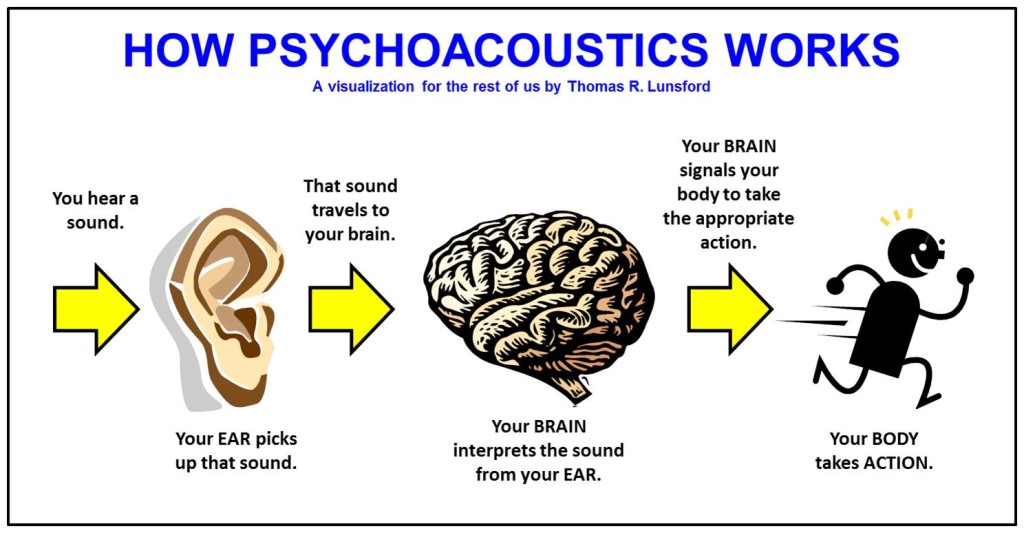
By Rajiv Agarwal
Every day, we hear a wide variety of sounds and noises that our brains must process for us so that we can make sense out of them. Some of these noises can be pleasant and others can be jarring. A nice piece of classical music can be soothing, but if your dog starts barking in your ears, then you might lose that soothing feeling. Psychoacoustics is basically the study of these psychological and physiological interactions with sound. Obviously, the way a sonata makes us feel is entirely different than the way Rover’s yap makes us feel.
The Basis of Psychoacoustics
Psychoacoustics essentially relies on the idea that sound waves produce unconscious activity within the brain. If you think of sound waves (including spoken words), you really have to think about them as aural units of measurement. Each of these units enters into the ear and then into the brain where both psychological and physiological changes can be observed. Obviously, we know that a song that makes us nostalgic is going to produce certain psychological shifts in perception.
But, there is also a physical component to the sound waves that makes its way into your brain. Each sound wave must be broken down by the brain into neural information. Obviously, this produces a wide array of action potentials that scurry around in your brain to make sense of the information. This happens much faster than we’re really able to realize, but that is the basic crux of psychoacoustics.
There is also clear evidence that slightly detuned tones can make brain waves speed up or slow down. We often think of sound as something that we merely keep hearing throughout the day, but we are also most of the time physically responding to the sounds around us, whether we know it or not.
The Implications of Psychoacoustics
The physiological response to sounds is something that has caused many scientists to look into psychoacoustics. There is an undeniable way in which the rhythms and noises in music affect the way we think, feel, and react physically. A song with an undeniably up-tempo beat might get your foot tapping or your body dancing, but those are generally conscious decisions that you make. What you might not realize is how the music is affecting the way your neurons fire and the way your entire nervous system is reacting to the change. A lot of evidence suggests that your nervous system is actually going to be jittery as a result of the faster tempo.
On the flip side, a song with a slower tempo or even the calming silence of the wind rustling through the trees can produce much calmer and more regulated neural action. A softer, steadier rhythm can help regulate breathing patterns or shift heart rates. Of course, the same is true for faster, more hectic rhythms except that breathing and cardiovascular patterns might be elevated.
Clearly, most of us would be more agitated trying to talk over the sound of a blaring, frenetic jackhammer than we might while sitting in a room with soft ambient music playing. While this might seem obvious to many, it actually has strong implications for what sound can do within the body and how we are influenced by sound during almost every waking moment. The concept is based on resonation or the idea that sound waves are constantly moving, reflecting, and being processed in and by our brains.

Practical Applications
There are really two distinct ways in which psychoacoustics can prove to be a highly legitimate field of study. Therapeutic sound has wide ranging indications for a number of different mental and physical illnesses. Of course, it doesn’t mean that patients will be subjected to 2 hours of easy listening music per day. Instead, sound frequencies are used to sort of retrain the brain to think differently. Many adults and children have already benefited from some of the finer nuances of psychoacoustics. For the most part, real progress has come in the way of subtracting lower frequencies and then reinserting them all during a single listening session. This has the effect of shifting the auditory processes which then essentially carves new molds in the neurodevelopmental processes as well.
The other practical application of psychoacoustics comes in the way of sound production and editing. The new understanding of how sound affects our physical body has caused the compression of sound data to be looked at more closely. When we listen to something like an mp3, we are obviously going to have a psychological and physiological response. But, when the sound is compressed into those smaller pieces of data, some of the integrity might be lost. Thus, the sound file might actually produce adverse reactions where none were intended. This has forced digital music and sound makers to rethink the way they process information in the form of noise.
Overall, psychoacoustics is a fascinating field of study that really delves into the ways that sound can truly affect us. Many people are already experiencing the benefits of “sound therapy” as a way to treat certain ailments. In the end, psychoacoustics makes us understand just how powerful sound is as a way of shifting both mental and physical reactions.
http://www.audioshapers.com delivers best audio editing, mixing, mastering and audio post production solutions. We also provide free customized samples. visit our website for great prices: click now!
Article Source: http://EzineArticles.com/?expert=Rajiv_Agarwal
Memtech Acoustical – Your Source for Noise Control Solutions
We provide total solutions, from the initial technical analysis, specification through purchase of materials, complete installation, and final verification of the results.
There is no need to call consultants, order acoustic materials and hire contractors…we do it all!
We will work in any commercial, industrial, or residential environment, anywhere in the world.

